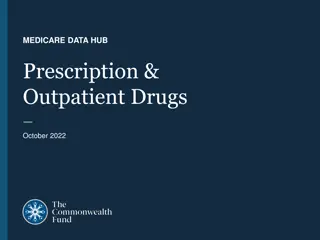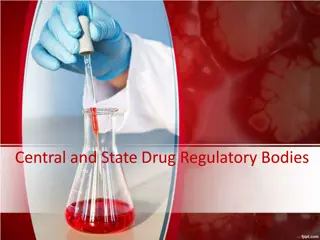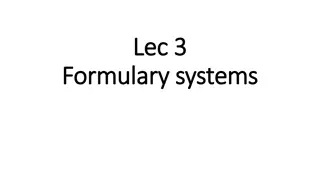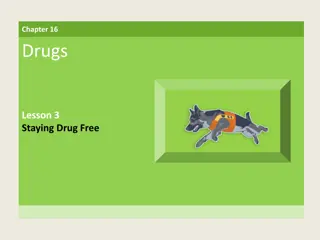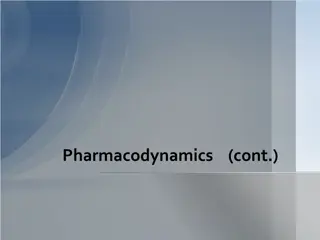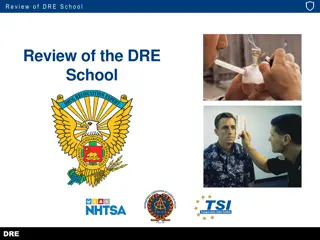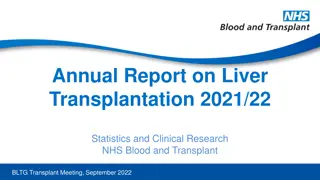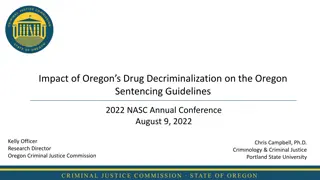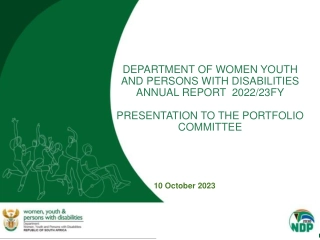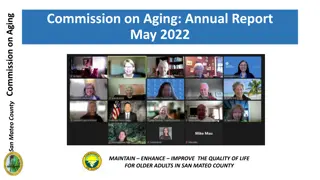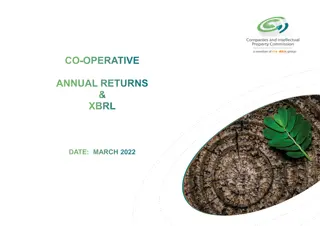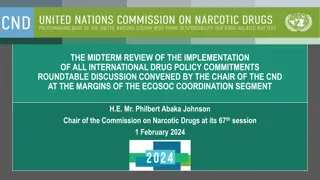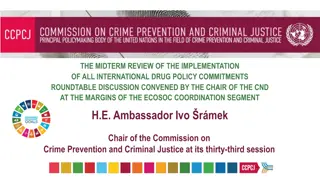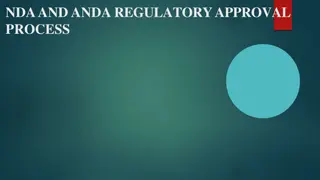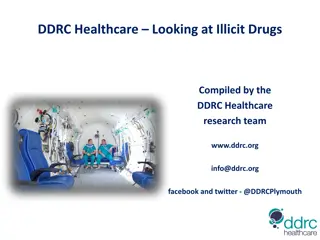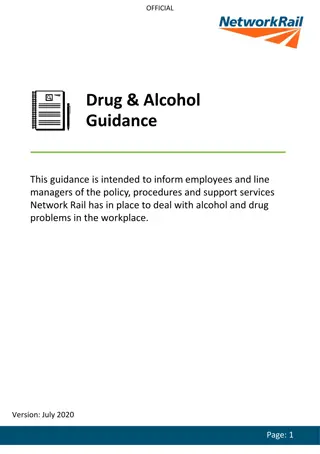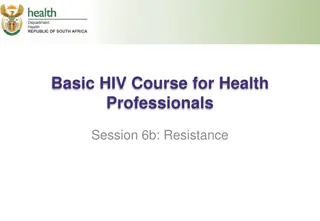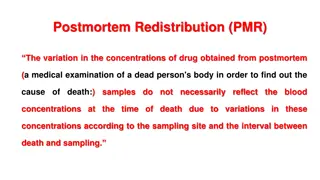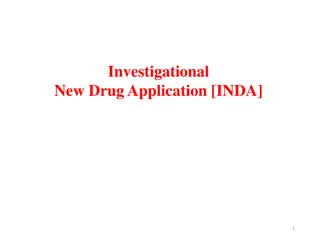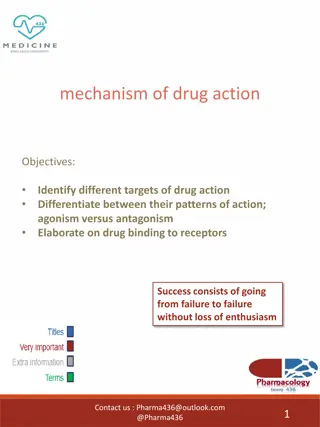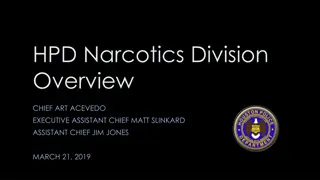Presentation on Central Drug Authority's 2021/2022 Annual Report
This presentation focuses on briefing the Select Committee on Health and Social Services regarding the Central Drug Authority's (CDA) annual report for 2021/2022. It highlights the progress made in implementing the National Drug Master Plan and emphasizes the CDA's role in coordinating efforts against substance abuse as mandated by the legislative framework. The CDA's powers and duties in overseeing the National Drug Master Plan and promoting collaboration among government departments are also outlined.
Download Presentation

Please find below an Image/Link to download the presentation.
The content on the website is provided AS IS for your information and personal use only. It may not be sold, licensed, or shared on other websites without obtaining consent from the author. Download presentation by click this link. If you encounter any issues during the download, it is possible that the publisher has removed the file from their server.
E N D
Presentation Transcript
PRESENTATION ON THE 2021/2022 ANNUAL REPORT OF THE CENTRAL DRUG AUTHORTY (CDA)
PURPOSE OF THE PRESENTATION To brief the Select Committee on Health and Social Services on the 2021/2022 annual report of CDA The Select Committee on Health and Social Services to note the 2021/2022 annual report of CDA The Select Committee on Health and Social Services to continuously provide support to CDA The Select Committee on Health and Social Services to encourage departments and its entities falling within its ambit to participate in the CDA structures
INTRODUCTION This presentation will highlight progress on the on the implementation of the National Drug Master Plan 2019-2024 from 1 April 2021 to 31 March 2022 as contained in the 2021/2022 Annual Report.
BACKGROUND The Central Drug Authority (CDA) is a statutory body established in terms of Section of the Prevention of and Treatment for Substance Abuse to monitor and oversee the implementation of the National Drug Master Plan. CDA is comprised of 11 members who have special knowledge and experience in the field of substance abuse and 21 National departments The current members of inaugurated in May 2021 Development. CDA by were the appointed Minister and of Social
LEGISLATIVE MANDATE The legislative mandate is derived from the Prevention of and Treatment for Substance Abuse Act, No. 70 of 2008 and its Regulations. Act, No 70 of 2008, mandates the Central Drug Authority to coordinate national efforts in the fight against substance abuse and to submit an annual report that sets out a comprehensive description of the national effort relating to the problem of substance abuse.
POWERS AND DUTIES The following are powers and duties of the CDA: Oversee and monitor the implementation of the National Drug Master Plan; Facilitate and encourage projects; Facilitate the rationalisation of existing resources and monitor their effective use; Encourage government departments and private institutions to compile plans to address substance abuse in line with the goals of the National Drug Master Plan; the coordination of strategic
POWERS AND DUTIES OF CDA Ensure that each department of state has its own performance indicators; facilitate the initiation and promotion of measures to combat the use of substances; Ensure the establishment and maintenance of information systems which will support the implementation, evaluation development of the National Drug Master Plan; Submit an annual report that sets out a comprehensive description of the national effort relating to the problem of substance abuse; and ongoing
POWERS AND DUTIES OF CDA Ensure the development of effective strategies on prevention, early intervention, reintegration and aftercare services, and in particular ensure the development of effective strategies regarding the prevention of HIV infection and other medical consequences related to substance abuse; Advise Government on policies and programmes in the field of substance abuse and drug trafficking; Recommend to Cabinet the review of the National Drug Master Plan every five years; Organise a biennial summit on substance abuse to enable role- players in the field of substance abuse to share information; and May exercise such powers and must perform such duties as may be determined by the Minister from time to time.
NATIONAL DRUG MASTER PLAN 2019-2024 Strategic Approach Vision A South Africa Free of Substance Abuse Mission Embrace a balanced integrated & evidence-based approach to domestic drug use , misuse & abuse; Invest in building safe communities through appropriate drug prevention & impact minimization strategies; Control the demand & supply of substance abuse & misuse; Effectively control substance for therapeutic use and the emergence of New Psycho-Active Substances
NATIONAL DRUG MASTER PLAN 2019-2024 Strategic Approach Principles Target Population Youth- In and Out of School Children Women incl pregnant women Persons with disabilities Occupational groups at risk Key populations e.g LGBTQI, prisons Inclusive and Participatory Rights based Evidence based Multi-sectoral and Multi-lateral People centred
NATIONAL DRUG MASTER PLAN 2019-2024 Strategic Intent 1. Demand reduction through prevention & treatment of drug use, misuse and abuse 7 Goals 2. Supply reduction through effective law enforcement & responding to drug related crimes and countering money laundering. 3. Control of drugs intended for therapeutic use. 4. Identification and control of new Psychoactive substances 5. Governance, leadership and accountability 6. Strengthening data collection, M & E and research 7. Stimulate robust and sustainable economic growth aimed at reducing poverty, unemployment and inequalities.
GOVERNANCE Functionality Functional Detail Chairperson and Deputy Chairperson Notes Strengthen secretariat support Executive Committee Functional Strengthen secretariat support Portfolio Committees: Programs and Projects Communications and Marketing Governance Research Development Monitoring and Evaluation Finance Social and Ethics All Functional Strengthen secretariat support General Committee Functional Highest decision-making body of the CDA Extended General Committee Functional Structures as indicated, PSAF s and other stakeholders 8 Provincial Substance Abuse Fora 8 Functional and 1 to be re-established Provide financial and human resources Local Drug Action Committee (259) Few established and functional Many still to be established. Established LDAC s require strengthening and support.
SITUATIONAL ANALYSIS This annual report is submitted in terms of Section 56(h) Act, which enjoins the CDA to provide a comprehensive description of how the country is addressing the above- mentioned challenges. South Africa was still grappling with COVID-19 and its challenges and consequences. COVID-19 Regulations. Restrictions included the complete prohibition of tobacco sales, to minimise tobacco-related risk of severe COVID-19 infection; and alcohol sales, to lower alcohol- related emergencies (such as from traffic accidents) in health care facilities and free up space for COVID-19 emergencies. Measures also restricted the nature and types of services that persons with substance abuse disorders (SUDs) could access and what services could be provided by SUD service providers. Situation in South Africa is examined against what prevails globally, as this invariably has an impact on the country and its response to the challenges of drug and other substance abuse.
GLOBAL SITUATIONAL ANALYSIS In 2020, one in 18 people aged 15 64 years (5.6% of the world s population) had used a drug within the last 12 months, representing an increase of 26% since 2010 (UNODC, 2022) Drugs killed almost half a million people in 2019, and drug use disorders resulted in 18 million years of healthy life lost, mostly due to opioids (UNODC, 2021). World Drug Report (WDR)projects that by 2030, the number of people using drugs will rise by 11% around the world, and by as much as 40% in Africa alone. WDR urges policymakers to note that illicit drug cultivation offers no way out for impoverished communities in the long run, that the drug trade has environmental impacts, and that drug trafficking along with associated corruption and illicit flows undermine the rule of law and stability. Markets for drugs are expanding to new and more vulnerable regions, and more young people are using drugs compared to previous generations In Africa, most people being treated for drug use disorders are under the age of 35 years. 40% of countries reported cannabis as the drug associated with the greatest number of drug use disorders.
SOUTH AFRICAN SITUATIONAL ANALYSIS In the absence of a national survey on substance abuse trends in the country, South Africa is dependent on the South African Community Epidemiology Network on Drug Use (SACENDU) and the World Drug Report (UNODC, 2021; 2022), whose data is sourced from participating treatment facilities across the country. During the first half of 2021, 10 938 people were admitted for treatment across the 94 treatment centres, compared to 9394 in 2022 Substance Substance Main Method of Use Methamphetamine Multiple Area of Most use Western Cape Eastern Cape Alcohol Drinking KwaZulu Natal Central Region Heroine/Nyaope Injecting Gauteng Northern Region
SOUTH AFRICAN SITUATIONAL ANALYSIS.. Substance Substance Cannabis Main Method of Use Area of Most use Smoking Western Cape Eastern Cape KwaZulu Natal Central Region Gauteng Northern Region Gauteng KwaZulu Natal Western Cape Nationawide Oral Methcathinone ( CAT ) Poly-substance use Multiple Over-the-counter (OTC) and prescription medicines Multiple Tobacco Smoking It is imperative that a national survey on trends of substance abuse be conducted in the country, to determine the trends and extent of substance/ drug abuse and the need, as well as the availability, accessibility and quality of services to respond to the need .
ALCOHOL USE AND ABUSE South Africa has the sixth highest per-person alcohol intake in the world and the highest alcohol consumption rate in Africa (11 litre per capita) Costs the country 12% of its annual GDP3, Fifth largest contributor to years of life lost, with alcohol-related illnesses disproportionately affecting socio-economic groups (Theron et al., 2022 Purposeful targeting of markets in low- and middle-income countries, particularly young people Research shows an association between alcohol market exposure and positive attitudes towards alcohol, earlier drinking initiation and high levels of consumption. National enjoyment of sports, such as rugby and soccer, There is a link between mental health and drinking (depression, risk of suicide, anxiety, low self-esteem, psychological distress, post-traumatic stress disorders) Social engagements tend to centre around drinking Alcohol abuse contributes to gender-based violence, HIV/Aids and other social and health conditions in South African society
STAKEHOLDER ENGAGEMENT International Stakeholders Commission on Narcotic Drugs UN Office on Drugs and Crime World Health Organisation African Union The Colombo Plan Brazil, Russia, India, China and South Africa (BRICS) Formal Anti-Drug Committee
STAKEHOLDER ENGAGEMENT National Stakeholders International Consortium of Universities for Drug Demand Reduction (ICUDDR) International Technology Transfer Centre (ITTC) SA National Council on Drugs and Alcoholism (SANCA) International Society of Substance Use Professional South Africa (ISSUP SA) South African Community Epidemiology Network on Drug Use (SACENDU) Medical Research Council (MRC) South African Network of People Who Use Drugs (SANPUD) South African Local Government Association (SALGA) South African National Aids Council (SANAC) International Network on Hepatitis in Substance Users (INHSU)
PERFORMANCE MANAGEMENT AND MONITORING National departments and entities and the provincial substance abuse forums (PSAFs) submit to the CDA annual reports on their sector drug master plan (DMP), which should be aligned to the NDMP. Note: Departments are complimented for submitting reports as expected and for attending CDA meetings, Timelines for submission of reports were generally not adhered to Departments are attempting to work together in clusters, However, many departments do not appear to understand the NDMP and the meaningful role that they can play. National Departments -Ideally, the reports should be read against the sector DMPs, which should have been compiled and costed. -Departments with DMP s are DSD. DoH, SAPS and DoJCS ( under review). -The CDA will focus on assisting departments to craft their sector DMPs and work with departments to integrate the NDMP goals and deliverables into their strategic plans and key performance indicators,
Provincial Substance Abuse Fora (PSAFS) NDMP template used NDMP goals PSAF Reports on Operational PSAF governance structure DSD convenor appointed Financial/huma n resources allocated Yes Eastern Cape Yes 4 Yes No No-Interim Chairperson Gauteng Yes 5 Yes No No-Dep Chairperson(s) to be appointed KwaZulu Natal Yes 5 Yes Yes Free State No 4 Yes Yes No Limpopo Yes 4 No(PSAF to be relaunched in 2022/23 FY) Yes No Mpumalanga Yes 5 Yes Yes Yes North West Yes 3 Yes Yes No Northern Cape No 1 No Yes No Western Cape Yes 4 Yes Yes No
NDMP 2019-2024 IMPLEMENTATION ANALYSIS Performance is measured in relation to the NDMP Goals, the MTSF Outcomes and the Resolutions of the National Conference on Substance Abuse and Family Related Interventions held in Ekurhuleni. GOAL ACHIEVEMENTS 2021/22 ANALYSIS RECOMMENDATIONS 1 Developed and engaged their employees, crime offenders, basic education school learners, parents, students in institutions of higher learning, in various substance abuse prevention, early intervention and awareness-raising strategies and campaigns. -South African Police (SAPS) conducted 4481 crime prevention awareness campaigns. In total, the national departments and entities reached out to a total of 73 432 people throughout the country Depts must conduct prevention and awareness campaigns in collaboration with other depts to rationalize use of resources and have impact. National Policy on Prevention of and Treatment of Substance use Disorder was developed and consulted with various stakeholders. -Policy is towards the review of the Prevention of and Treatment for Substance Use Act 2008(Act, no 70 of 2008) DSD to finalize process towards review of Act. No 70 of 2008
NDMP 2019-2024 IMPLEMENTATION ANALYSIS GOAL ACHIEVEMENTS 2021/22 ANALYSIS RECOMMENDATIONS 1 On treatment and harm reduction, the national Departments of Social Development, Health and Correctional Services continued with providing treatment to users in the public treatment centres and ensured adherence to norms and service standards. The Department of Health developed a comprehensive and costed opioid substitution treatment (OTP) plan and clinical guidelines for the treatment of people with SUDs with support from the WHO Government to upscale and fund more OTP programmes throughout the country in order to reduce harm Practitioners in treatment centres were trained and capacitated on the universal treatment curriculum and on psychosocial support guidelines. Peer educators were trained on evidence-based treatment programmes.
NDMP 2019-2024 IMPLEMENTATION ANALYSIS GOAL ACHIEVEMENTS 2021/22 ANALYSIS RECOMMENDATIONS 1 Department of Social Development also monitored the implementation of the strategy on reintegration and aftercare programmes for recovering users. DSD to provide numbers of recovering users that gained access to aftercare and reintegration services after treatment Upscale aftercare, skills development, employment and entrepreneurship programmes for the recovering users Non-governmental organisations were funded to provide outpatient treatment and prevention programmes and were monitored for compliance with service standards. Database of these funded organisations is with the Departments of Social Development and Health. Monitoring of unfunded treatment centers needs to be prioritized. Operations to monitor need to be in collaboration with security cluster departments
NDMP 2019-2024 IMPLEMENTATION ANALYSIS GOAL ACHIEVEMENT 2021/22 ANALYSIS RECOMMENDATIONS 2 None Department of Justice and Constitutional Development published the Cannabis for Private Purpose Bill No. 19 of 2020 in the Government Gazette. Public hearings were held, and the bill is now before the Portfolio Committee for a clause-by-clause reading. CDA to monitor the effectiveness of these collaborations on supply demand National Prosecuting Authority (NPA) collaborated with SAPS including the Directorate for Priority Crime Investigations to mitigate the supply of drugs in an effective manner CDA to monitor this situation Enhanced the processing of forensic evidence for drug-related investigations, reduced identified drug syndicates, dealt with organised crime threat, enhanced intelligence and effectiveness of law enforcement
NDMP 2019-2024 IMPLEMENTATION ANALYSIS GOAL ACHIEVEMENT 2021/22 ANALYSIS RECOMMENDATIONS 2 CDA to measure effectiveness and impact of these partnerships Strengthened partnerships in monitoring chemical companies, receive import notifications on online system, SAPS achieved 98% of finalising import notifications and 93.7% of export notifications Addressed the illegal trade of liquor and other drugs Conducted liquor operations Undertook border-post policing actions movement Used enhanced movement and movement- controlled systems on persons and vehicles. Undertook actions targeted at drug trafficking in land ports, seaports and airports CDA to measure the effectiveness and impact of these operations CDA to undertake oversight visits at airports to monitor this work To mitigate the supply of drugs and liquor, the South African Revenue (SARS) undertook 913 risk analysis and narcotics seizures at airports worth R409-million and 898 at 16 airports worth R31.4-million.
NDMP 2019-2024 IMPLEMENTATION ANALYSIS GOAL ACHIEVEMENT 2021/22 ANALYSIS RECOMMENDATIONS 3 CDA to monitor this work Department of Health and SAHPRA implemented the controlled licensing and permit processes 4 Detected seven cases were new psychotropic/psychoactive substances identified and detected. CDA needs to encourage all other provinces to carry out activities under this goal and report back. CDA to monitor trends of NPS Monitored the trends in the composition, production, distribution of NPS, amphetamine type stimulants (ATS) and other chemicals used for illicit drugs and arrested 274 drug dealers. Trained government officials in NPS in KZN Dagga, cocaine, crystal meth, heroine, nyaope and other chemicals were confiscated in Gauteng and Mpumalanga
NDMP 2019-2024 IMPLEMENTATION ANALYSIS GOAL ACHIEVEMENT 2021/22 ANALYSIS RECOMMENDATIONS 5 Department of Social Development delegated the Chief Director on Substance Abuse and Social Crime Directorate and employed the Secretariat comprising 2 social work policy officials and 2 administrators Secretariat has limited capacity to effectively support the CDA DSD to employ a Director as prescribed by the Act (No. 70 of 2008). CDA successfully held meetings with departments and entities towards appointment of representatives Government departments, entities and PSAFs to develop their sector drug master plans CDA delegated each independent member to a province, in order to ensure the PSAFs and LDACs were functioning, capacitated on the NDMP and encouraged to report to the CDA undertook a strategic planning session jointly with the government departments and developed the 2022 25 Medium Term Performance Plan and the 2022 23 Annual Performance Plan
NDMP 2019-2024 IMPLEMENTATION ANALYSIS GOAL ACHIEVEMENT 2021/22 ANALYSIS RECOMMENDATIONS 5 Involved strategic stakeholders who are not necessarily members of the CDA, to review the 3rd CDA s Annual Report, which the 4th CDA had prepared. The CDA will involve these and other more strategic stakeholders in planning and in reviewing the implementation of the NDMP. CDA will continue to pursue the allocation of budgets for the roll- out of the NDMP CDA has been encouraging government departments and entities to allocate budgets for the rollout of the NDMP CDA has not had direct contact and engagement with the World Health Organisation (WHO) and the African Union (AU) SAHPRA has added 20 substances to Schedule 7 of the Schedules to the Medicines Act in line with the recommendations of the 63rd meeting of the Commission on Narcotic Drugs
NDMP 2019-2024 IMPLEMENTATION ANALYSIS ACHIEVEMENT 2021/22 GOAL ANALYSISS RECOMMENDATIONS 5 Involved strategic stakeholders who are not necessarily members of the CDA, to review the 3rd CDA s Annual Report, which the 4th CDA had prepared. The CDA will involve these and other more strategic stakeholders in planning and in reviewing the implementation of the NDMP. CDA will continue to pursue the allocation of budgets for the roll- out of the NDMP CDA has been encouraging government departments and entities to allocate budgets for the rollout of the NDMP CDA has not had direct contact and engagement with the World Health Organisation (WHO) and the African Union (AU) SAHPRA has added 20 substances to Schedule 7 of the Schedules to the Medicines Act in line with the recommendations of the 63rd meeting of the Commission on Narcotic Drugs
NDMP 2019-2024 IMPLEMENTATION ANALYSIS GOAL ACHIEVEMENT 2021/22 ANALYSIS RECOMMENDATIONS 5 N/ Cape is planning to establish the PSAF CDA to ensure that the 9th PSAF is established All nine PSAFs have been established in accordance with the Act, and eight are functional An audit of established and functional LDAC s has to be conducted 31 Local Drug Action Committees (LDACs) have been established and are functioning at varying levels The CDA is collaborating with SALGA and the PSAFs to encourage and capacitate mayors to establish and support LDACs 6 Contract has been extended Department of Health has a contract with the SAMRC for SACENDU to collect data on drug use, Much more work still needs to be done to achieve this goal. Four quarterly reports were received, which highlighted a significant decrease (51%) in the number of children arrested for possession and/or use of drugs.
NDMP 2019-2024 IMPLEMENTATION ANALYSIS GOAL ACHIEVEMENT 2021/22 ANALYSIS RECOMMENDATIONS 6 CDA to collaborate with research institutions to undertake the national prevalence survey on drugs and alcohol There s no national research agenda One province reported to have developed a provincial database and has conducted monitoring sessions for compliance of treatment centres with norms and standards. 7 Departmental representatives in the CDA have been alerted to report on this goal as work is known to have been done but it is not reported on CDA to engage economic cluster departments in the 2022/23 FY towards implementation of this goal None of the departments reported on this goal. All provinces must execute this critical goal to address root causes of drug and alcohol abuse CDA to monitor implementation of this goal closely 7 provinces carried out activities aimed at reducing poverty, unemployment and inequalities especially among substance users who are recovering, including their families.
RECOMMENDATIONS It is recommended that the Select Committee on Health and Social Services: Note the 2021/2022 annual report of CDA Provide continuous support to CDA Encourage departments and its entities falling within its ambit to participate in the CDA structures


